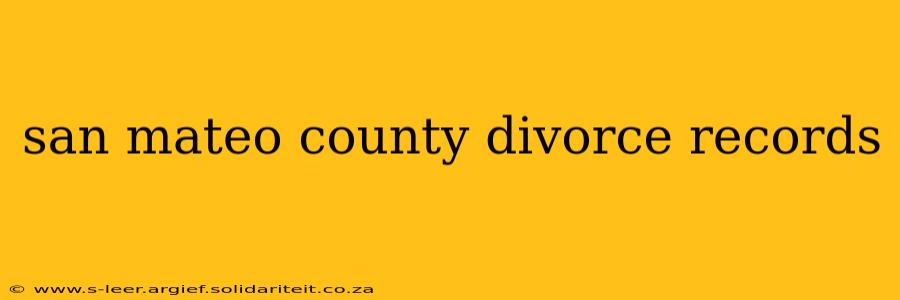Divorce records in San Mateo County, California, hold significant personal and legal information. Understanding how to access these records, the types of information contained within, and the legal considerations involved is crucial for anyone needing this data. This comprehensive guide will walk you through the process, addressing common questions and concerns.
Where are San Mateo County Divorce Records Located?
San Mateo County divorce records are primarily housed at the San Mateo County Superior Court. They are not available online through a centralized, searchable database. This means obtaining these records requires a more hands-on approach than simply searching a website.
What Information is Contained in San Mateo County Divorce Records?
Divorce records typically include a wealth of information about the individuals and the proceedings. This might encompass:
- Names and addresses of the parties involved: This is usually the most readily accessible information.
- Date of marriage and date of separation: Crucial details for understanding the timeline of the relationship.
- Date of filing and date of finalization of the divorce: Marking the official beginning and end of the legal process.
- Reasons for divorce: Although not always explicitly stated, the filings might hint at the grounds for the separation.
- Details of property division: Information concerning the distribution of assets, debts, and possessions.
- Child custody and support arrangements: If children are involved, these records will detail custody arrangements, visitation schedules, and child support obligations.
- Spousal support (alimony) agreements: This section will outline any financial support awarded to one party by the other.
How Can I Obtain San Mateo County Divorce Records?
Accessing San Mateo County divorce records typically involves visiting the San Mateo County Superior Court Clerk's Office in person or submitting a written request. The process usually involves:
- Identifying the Case: You will need identifying information about the individuals involved in the divorce, such as their names and the approximate date of the divorce.
- Submitting a Request: You'll likely need to fill out a request form and pay a fee. The specific requirements might vary, so it's best to contact the Clerk's Office directly.
- Reviewing the Records: Once the request is processed, you'll be able to review the relevant records. Be aware that certain parts of the record might be sealed or confidential, requiring a court order to access.
What are the Fees Associated with Obtaining Divorce Records?
Fees for obtaining divorce records vary. It's essential to contact the San Mateo County Superior Court Clerk's Office directly to inquire about current fees. The cost typically depends on the type of record requested and the extent of the search.
Are San Mateo County Divorce Records Public?
While many aspects of divorce records are considered public information, some parts, particularly those related to child custody and financial details, might be sealed or redacted to protect the privacy of the individuals involved. The court has the authority to limit access to sensitive information.
Can I Access San Mateo County Divorce Records Online?
Unfortunately, there isn't a readily available online database for San Mateo County divorce records. The process generally requires an in-person visit or a written request to the Superior Court.
What if the Divorce Happened Before Computerized Records?
If the divorce occurred before the widespread use of electronic record-keeping, obtaining the records might require a more extensive search, potentially involving manual record reviews by court personnel.
This guide provides a general overview. For the most up-to-date and accurate information, always contact the San Mateo County Superior Court Clerk's Office directly. Remember to respect the privacy of those involved and adhere to all legal requirements when accessing these records.
